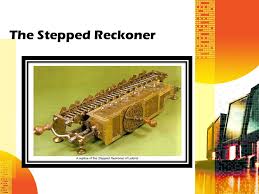History of Computers
A computer has three essential characteristics:
1.It responds to a specific set of instructions in a well defined manner
2. It can execute a pre-recorded set of instructions
3. It can quickly store and retrieve large amounts of data
Computers in their simplest form can be traced back to 3000 BC in the form of abacuses.
The first use of the word computer is said to have been done in 1613 AD, referred to a person who performed calculations or computations and continued to be used in that sense in the 20th century
The origin of the computer can be traced to first tally sticks and then abacuses

Tally Stick (above)

Abacus
This was followed by Napier's Bones invented by John Napier in 1614.
It allowed the user to multiply, divide and calculate sq roots and cube roots by moving the rods around and placing them in specially constructed boards

The Slide Rule followed in 1622 based on Napier's logarithms

In 1672 came the Stepped Reckoner

This could add, divide, multiply and subtract automatically
1.It responds to a specific set of instructions in a well defined manner
2. It can execute a pre-recorded set of instructions
3. It can quickly store and retrieve large amounts of data
Computers in their simplest form can be traced back to 3000 BC in the form of abacuses.
The first use of the word computer is said to have been done in 1613 AD, referred to a person who performed calculations or computations and continued to be used in that sense in the 20th century
The origin of the computer can be traced to first tally sticks and then abacuses
Tally Stick (above)
Abacus
This was followed by Napier's Bones invented by John Napier in 1614.
It allowed the user to multiply, divide and calculate sq roots and cube roots by moving the rods around and placing them in specially constructed boards
The Slide Rule followed in 1622 based on Napier's logarithms

In 1672 came the Stepped Reckoner
This could add, divide, multiply and subtract automatically

Comments
Post a Comment